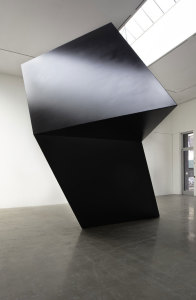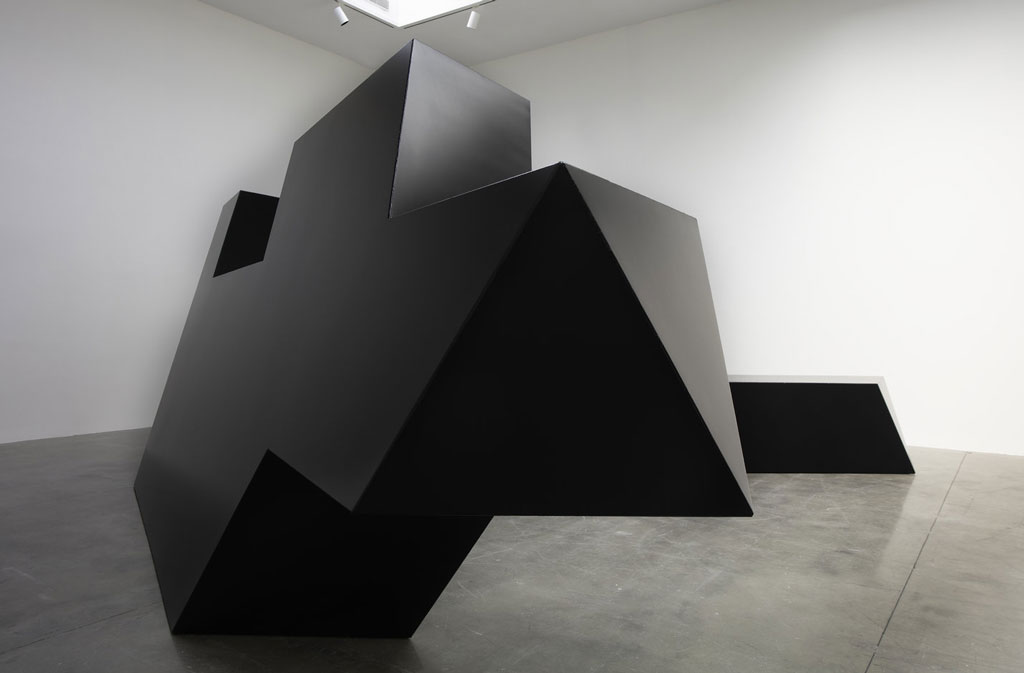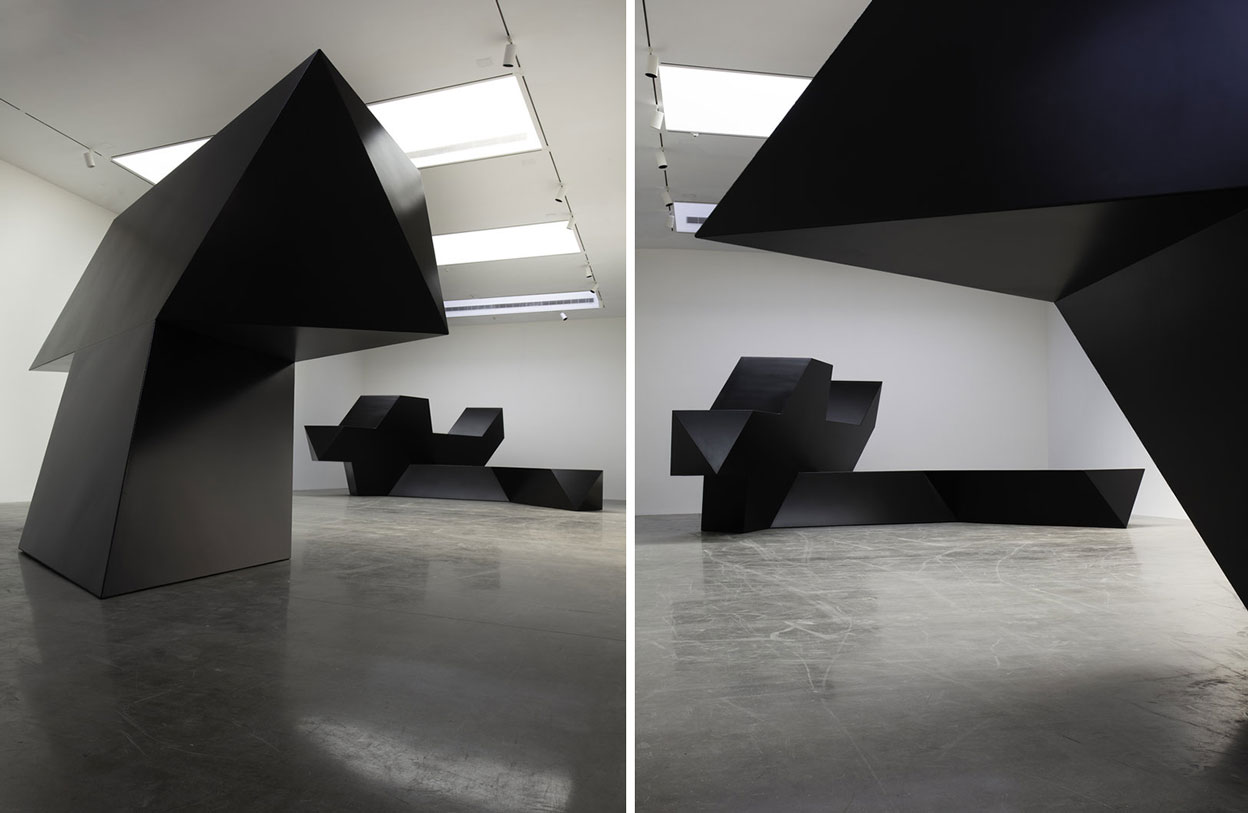ART-PRESENTATION: Tony Smith-Source, Tau, Throwback
 By the early 1960s, Tony Smith had begun to experiment with a particular method of working in sculpture which was to become his signature, combining the complex shapes of tetrahedrons and octahedrons into large-scale masses. The resulting sculptures present a formidable manipulation of geometric and biological form that is both complex and seemingly intuitive.
By the early 1960s, Tony Smith had begun to experiment with a particular method of working in sculpture which was to become his signature, combining the complex shapes of tetrahedrons and octahedrons into large-scale masses. The resulting sculptures present a formidable manipulation of geometric and biological form that is both complex and seemingly intuitive.
By Efi Michalarou
Photo: Pace Gallery Archive

Spanning Smith’s career in the medium, from the early 1960s to the late 1970s, the works in the exhibition “Source, Tau, Throwback” epitomize Tony Smith’s characteristic black-painted aesthetic articulated in large-scale and mathematically-determined geometric forms. The works also illustrate the artist’s shifting modes of formal construction and geometric massing, as well as his evolving approach to sculpture’s relationship to the body and surrounding environment. The artist’s first work to be placed on permanent display in a public space in New York, “Tau” (1961-62) was one of a series of new sculptures conceived by Smith as a speculation in pure form. While “Tau” was not installed outside Manhattan’s Hunter College until 1984, four years after the artist’s death, Smith created the sculpture with a vision to animate its immediate environment, not simply adorn it, to powerfully confront the daily masses of students and the public that traveled the corner each day. In a manner that would come to characterize many of Smith’s sculptures, Tau is constructed of tetrahedral modules that have been precisely and idiosyncratically stacked; yet the fundamental geometry of the piece is concealed by Smith’s distinctive material and finish – steel painted in semi-gloss black. “Source” (1967) was first exhibited the following summer at Documenta IV in Kassel, Germany and more recently was presented by Pace at Art Basel Unlimited in 2017. Encompassing two, united sections that span more than 7,5 meters across and rise over 2.8 meter high at the tallest point, “Source” marked a significant moment in the trajectory of Smith’s work. Whereas “Tau” functions as an intrusive object in space, in “Source”, Smith advanced sculpture’s ability to create a spatial field of its own. Through its composition of various-height walls, cantilevered forms, and competing acute and oblique angles, the sculpture activates the area that surrounds it, drawing people into a heightened level of physical engagement and fostering its own sense of interior and exterior space. “Throwback” (1976-77) was presented in Smith’s first exhibition at Pace Gallery in 1979. That exhibition, “Tony Smith: Ten Elements and Throwback,” featured a painted plywood version of the sculpture realized at Smith’s full intended size, as well as a smaller version in black-painted steel. Now, exactly forty years later, Pace exhibits “Throwback” as the artist originally envisioned-rendered in painted black aluminum at full scale. While composed of Smith’s familiar combination of tetrahedrons and octahedrons, it ranks among Smith’s most complex and dynamic forms. Its crystalline shape projects erratically into space, destabilizing the boundaries between sculpture, viewer, and environment. Tony Smith was born on September 23, 1912, in South Orange, New. In his early twenties, while helping with the family business, Smith attended the Art Students League of New York, studying painting, drawing, and anatomy. In 1932, Smith visited the International Style architecture exhibition at the Museum of Modern Art and was deeply impressed by it. A few years later, he moved to Chicago to attended the New Bauhaus, Chicago (1937–38) and work in the offices of Frank Lloyd Wright before striking out on his own as an architectural designer. Though he received several prominent commissions, Smith became disillusioned with the business and returned to New York to focus on his art. During the 1940s and 1950s, Smith continued to paint, befriending the Abstract Expressionist artists Barnett Newmann, Jackson Pollock, Mark Rothko, and Clyfford Still. He also began to experiment with simple, three-dimensional geometric shapes, combining and then enlarging them to create drama through scale. While the mock-ups were often made of cardboard or wood, the final work was envisioned in steel. Smith exhibited this new form of sculpture for the first time in 1964; in 1967 he made the cover of TIME Magazine as “Master of the Monumentalists.” He had become an international sensation. A major retrospective at the Museum of Modern Art, New York, in 1998 introduced Smith’s daring work to a new generation of viewers. Tony Smith created many of his famous sculptures in his original childhood home in South Orange, where he lived with his wife Jane and their daughters Kiki, Seton, and Beatrice. Often he created plywood mock-ups of these works in his backyard.
Info: Pace Gallery, 510 West 25th Street, New York, Duration: 26/4-22/6/19, Days & Hours: Tue-Sat 10:00-18:00, www.pacegallery.com




